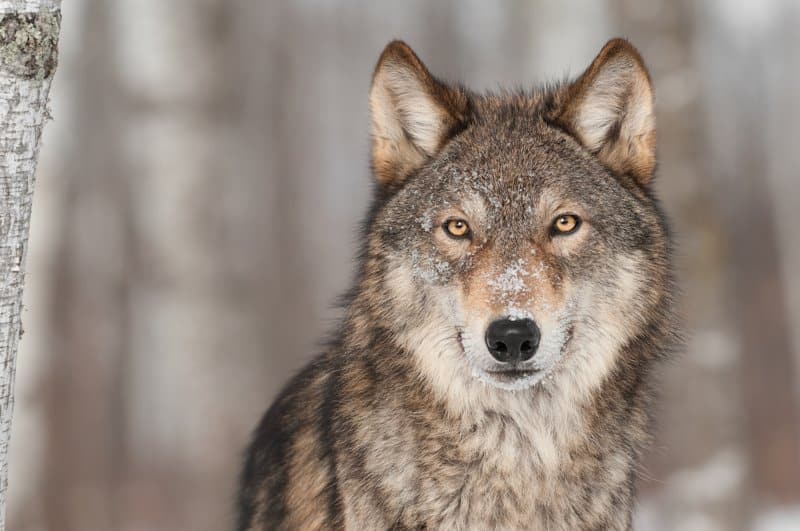Raw Diets Make Sense for Dogs and Cats
Dogs and Cats are Carnivores
All breeds of dogs are 99.9% genetically equivalent to the grey wolf.1 Even the giant and toy breeds hardly differ internally from the wolf. Domestic cats are strict carnivores, requiring even higher levels of protein and fat, than dogs need to thrive.
Over thousands of years, dogs evolved from wolves as humans befriended the good-natured pups lingering around their waste piles, camps, and villages. Dogs will scavenge to stay alive and are considered opportunistic carnivores that will eat some vegetation. However, their diet of choice (that is, their species appropriate diet) is raw meat and bone, as well as blood, organs, and organ contents of prey animals.
Years ago, The Timber Wolf Preservation Society in Greendale, Wisconsin fed its pack an average of 4 to 5 pounds of raw chicken bone-in meat and beef hearts per day, along with donations of kibble on which the wolves are allowed to free feed. They were not vaccinated and were monitored by vets at the UW Madison School of Veterinary Medicine. The average life span of a Timber Wolf Preservation Society animal was 13 to 18 years. The organization is now closed but no one, including their veterinarians, questioned the feeding practices.
Dogs have not evolved beyond this diet of mostly raw meat and do not have bodies designed to use high levels of carbohydrates for energy over the long term. Carbohydrate overload, along with over-vaccination and cosmetic breeding, seem to be a major precursor to disease in our domestic animal population.
1 Marion Schwartz, A History of Dogs in the Early Americas (New Haven: Yale University Press, 1997)
The Pet Food Industry and Evolution
Dry kibble and canned pet foods were designed for the convenience of humans, not for the health of the pet. From the minute food is cooked, it is less than natural — the nutrient content becomes markedly diminished. Original dog food companies sold raw horse meat to breeders and kennels because it was known and accepted that dogs are carnivores and should eat raw meat. It was suddenly, and approximately just 100 years ago, that grain-based diets were introduced to dogs and cats; not nearly enough time for their systems to evolve to accommodate and utilize carbohydrates as a main energy source.
Most kibbles are 40%-plus grain, cooked at high temperatures, and use low-quality ingredients such as meat and bone meals made by rendering plants, which can be contaminated with heavy metals, drugs, and other toxins. They often contain fillers to bulk the stool, such as beetroot powder, and are fortified with large amounts of synthetic vitamins, which some believe are not as easily absorbed as food-based nutrients.
This, along with over-vaccination and cosmetic breeding, has caused a dramatic increase in canine and feline diabetes, cancers, autoimmune disorders, joint and digestive disorders, and allergy-related chronic ailments. Domestic animal immune systems are often suppressed due to poor nutrition, which leaves them more susceptible to parasite infestations, fungal infections, tooth decay, and digestive disorders.
Preservatives, color and flavor enhancers, and rancid and dangerous trans-fats are also used to “trick” animals into eating the dry foods. If kibble manufacturers didn’t disguise the true taste and smell, dogs would likely avoid it all together. Cats are easily addicted to flavor enhancers and additives such as propylene glycol and sugar; they might go on hunger strike if they don’t get the food, they are used to eating year after year.
Why Many Vets Are Not Aware
Many people choose to make their own pet food because they realize it’s about as complicated as preparing meals for their family and it’s totally worth the effort. Julia Child once said, “You don’t have to cook fancy or complicated masterpieces, just good food from fresh ingredients.” What makes so many people think it is any different for their pets? The answer is the pet food industry, as well as our vets who have been trained in nutrition by the pet food industry, if they’ve been trained in nutrition at all. In most vet schools, nutrition courses are elective.
Vets often promote and sell some foods because those brands, (owned and produced by corporate conglomerates), offer high profit margins to the clinics. Corporations often provide vet schools with computers, textbooks, and nutritional information, which is based on their scientific research, conducted on their research on animals. Most conventionally trained vets don’t know anything else about pet food ingredients and pet nutrition unless they have done research in their own time.
These days, many holistically minded veterinary offices offer several varieties and brands of raw pet food. Progressively thinking vets are becoming aware of the relationship between pet food and pet health or disease.
Enzymes: The Key to Health
Raw foods have live enzymes present that are crucial in both the breakdown of food and the absorption of nutrients. Cooked foods (i.e. kibbles and canned foods) lack these enzymes and force the pancreas to work harder to provide the enzymes necessary to break down food for fuel. A lack of proper enzymatic activity in the diet would cause a myriad of health problems in any animal. Pets don’t have digestive enzymes in their saliva, as humans do, so cooked food can decay in their mouth and causes gum disease and dental disease over time. Raw foods, with enzymes intact, can break down quicker, which may naturally limit the production of bacteria and tartar. http://www.living-foods.com/articles/rawvscooked.html
Back to Basics
The Prey Animal Concept is an easy one to follow if you just imagine your dog eating a whole chicken, duck, pheasant, deer, rabbit, or fish. The same goes for a cat eating a mouse, bird, or rabbit. Over the past 30 years, a movement has taken hold in the US, Europe, Canada, Japan, and Australia and beyond, of people making their own pet food or buying prepackaged raw foods for their companion animals. When considering home-prepared meals, the ingredients are easy to get, often less expensive than your own groceries, and are all human-grade in quality. Anyone can do it, on almost any budget, with the help of a book or two and a bit of confidence.
Natural Raw Food and Your Pet: 5 Reasons to Choose Raw
- Raw food is a species appropriate diet for dogs and cats.A species appropriate diet is the most important thing we can offer our pets to help maximize life and enjoy their health to the fullest. Fresh raw meat, raw bones and a few items of vegetation are what the canine and feline bodies are designed to utilize for life.
- Boost your pet’s immune system.A diet including raw whole foods served in variation over time will help give your pet a healthy immune system and healthy bones, teeth, coat, and skin.
- Avoid common diseases and chronic illness.Raw food along with plenty of exercise and sunshine will help your pets avoid diseases like
- cancer
- diabetes
- heart failure
- kidney failure
- auto-immune disorders
and chronic illnesses like
- allergies
- fungal infections
- digestive disorders
- Standard processed pet foods use poor quality ingredients.Today our companion animals are being used as a way to recycle poor quality grains, protein and fats not fit for human consumption, and otherwise considered waste materials from the human food industry, agribusiness and rendering plants. The nutritional values of these ingredients are very low and must be fortified to meet the accepted nutritional standards for dogs and cats to sustain life.
- Dangerous substances are added to standard processed pet foods.Preservatives, additives, colors, flavor enhancers and other dangerous non-nutritive substances are added to these waste ingredients to extend their shelf life and make them palatable. Then they are cleverly marketed under the guise of veterinarian recommendation and endorsement as the best foods you can feed your pets.Many people, including animal nutritionists and veterinarians, are realizing that the commercial pet food industry is not necessarily providing the optimal diet for health and longevity of dogs and cats.

